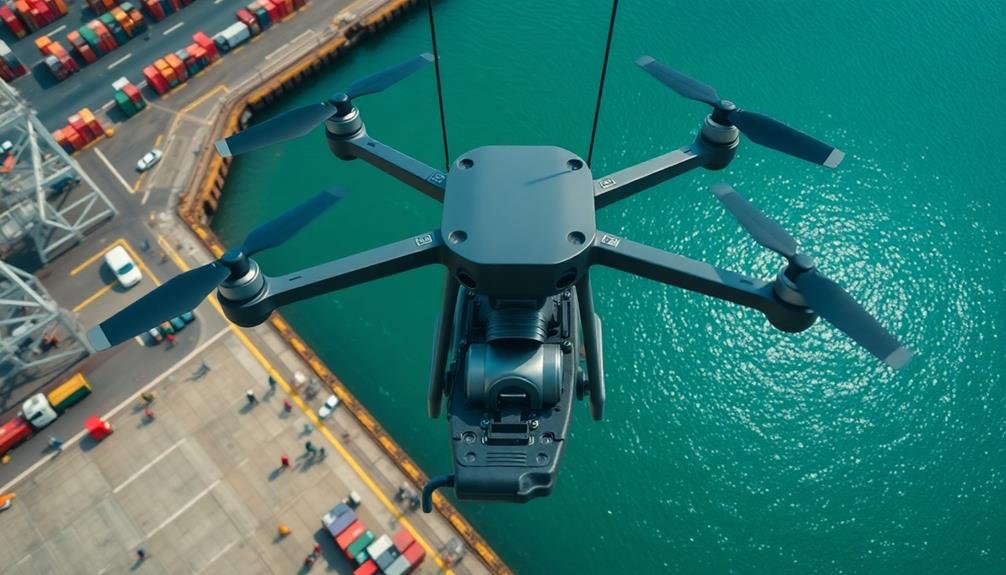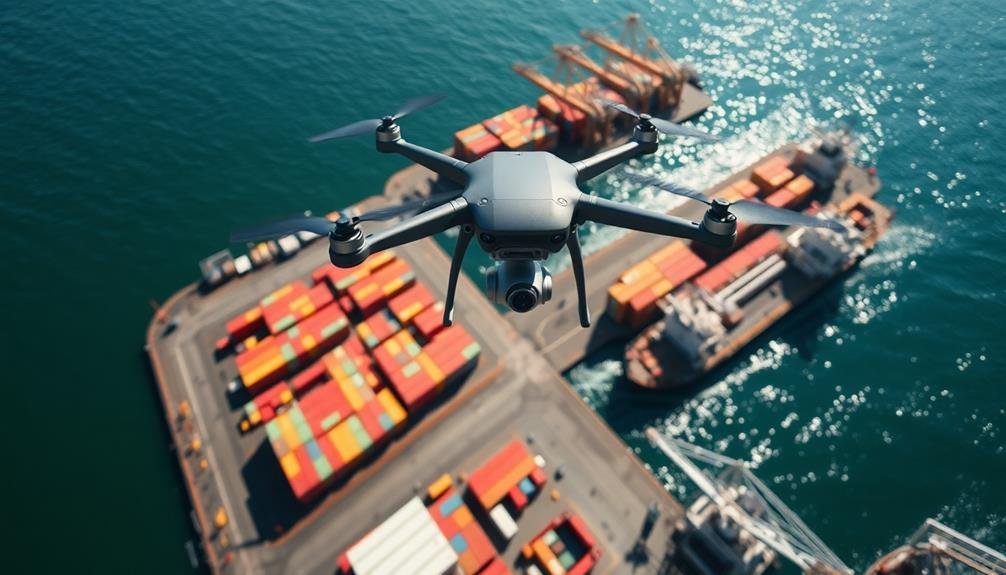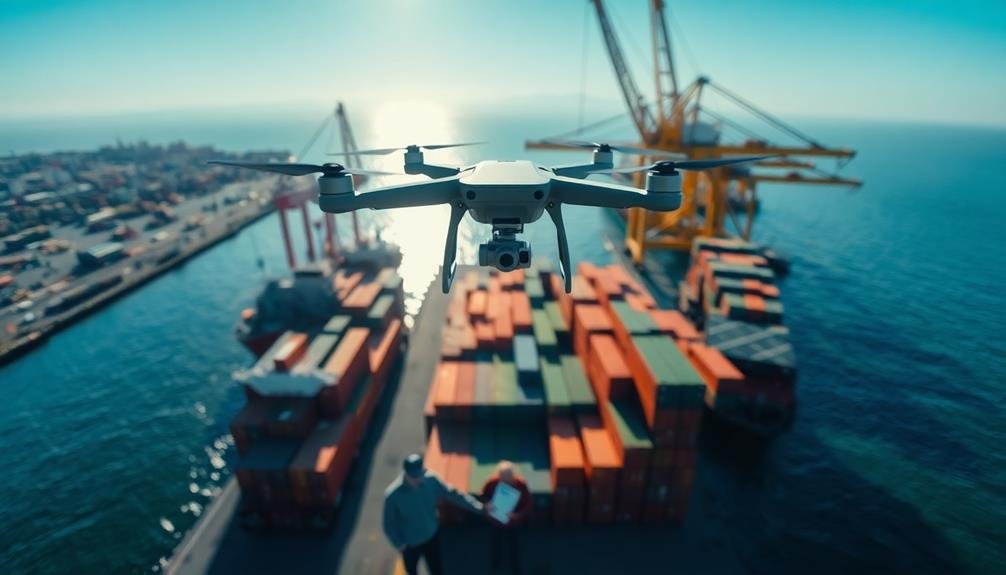Drone inspections offer three major benefits for port facilities. First, they enhance safety by reducing risks associated with traditional methods and accessing hard-to-reach areas. Second, they're cost-effective, decreasing inspection time and resources while allowing for more frequent monitoring. Third, drones improve efficiency and accuracy, covering large areas quickly and providing high-resolution imagery for detailed analysis. With specialized sensors like thermal imaging and LiDAR, you'll detect issues early, preventing costly breakdowns and minimizing downtime. By embracing drone technology, you'll revolutionize your port facility management, ensuring safer, more efficient operations. Discover how these aerial inspections can transform your port's performance.
Key Takeaways
- Drones enhance safety by accessing hard-to-reach areas like cranes and ship hulls without risking worker safety.
- Cost-effective monitoring reduces labor expenses and allows for more frequent inspections of port facilities.
- Improved efficiency enables quick coverage of large areas and easy access to difficult spots.
- High-resolution imagery and specialized sensors provide detailed, accurate data for risk-free analysis.
- Early detection of issues through drone inspections prevents costly repairs and minimizes operational downtime.
Enhanced Safety

In recent years, drone inspections have revolutionized safety protocols at port facilities. You'll find that these unmanned aerial vehicles greatly reduce the risks associated with traditional inspection methods. By utilizing drones, you can inspect hard-to-reach areas, such as tall cranes, cargo ship hulls, and storage tanks, without putting workers in harm's way.
Drones equipped with high-resolution cameras and sensors allow you to detect potential hazards, structural weaknesses, or maintenance issues before they escalate into dangerous situations. You'll be able to identify corrosion, cracks, or other damage that might compromise the integrity of port infrastructure. This proactive approach helps prevent accidents and guarantees the safety of both workers and cargo.
Moreover, you can conduct inspections more frequently and efficiently with drones, minimizing disruptions to port operations. You'll also reduce the need for scaffolding, lifts, or other equipment that could pose safety risks.
Cost-Effective Monitoring
Numerous port facilities have discovered that drone inspections offer a cost-effective solution for monitoring operations and infrastructure.
You'll find that drones considerably reduce the time and resources required for routine inspections. Instead of mobilizing large teams and equipment, you can deploy a single drone operator to cover vast areas quickly and efficiently.
You'll save on labor costs, as drones can access hard-to-reach areas without the need for scaffolding, cranes, or other expensive equipment. This means you'll spend less on rental fees and avoid potential workplace accidents.
Drones also allow you to conduct more frequent inspections without disrupting port operations, minimizing downtime and associated revenue losses.
With high-resolution cameras and sensors, you'll capture detailed imagery and data that can be analyzed remotely. This reduces the need for on-site personnel and allows for more thorough inspections.
You'll also benefit from early detection of issues, preventing costly repairs down the line. By implementing drone technology, you'll optimize your monitoring processes, reduce operational expenses, and improve overall efficiency in your port facility management.
Improved Efficiency and Accuracy

Beyond cost savings, drone inspections greatly boost efficiency and accuracy in port facility management.
You'll find that drones can cover large areas quickly, accessing hard-to-reach spots with ease. They capture high-resolution images and videos, allowing for detailed analysis without risking human safety. This technology enables you to detect issues earlier, preventing costly breakdowns and minimizing downtime.
Drones equipped with specialized sensors can collect a wide range of data, enhancing the accuracy of your inspections.
You'll benefit from:
- Thermal imaging to detect heat anomalies
- LiDAR for precise 3D mapping
- Multispectral cameras for vegetation analysis
- Gas sensors for air quality monitoring
- Moisture detectors for corrosion assessment
Frequently Asked Questions
What Types of Drones Are Best Suited for Port Facility Inspections?
You'll want to use waterproof drones with high-resolution cameras and thermal imaging capabilities. Quadcopters are ideal for maneuverability, while fixed-wing drones can cover larger areas. Don't forget to take into account battery life and wind resistance for port environments.
How Often Should Drone Inspections Be Conducted at Port Facilities?
You'll want to conduct drone inspections at port facilities quarterly, but adjust based on your specific needs. High-traffic areas may require monthly checks, while less-used sections could be inspected semi-annually. Always follow local regulations and guidelines.
Are There Any Regulatory Restrictions on Using Drones for Port Inspections?
You'll need to check local regulations, as drone use for port inspections may be restricted. FAA rules apply in the US, and you'll likely need special permissions for flying in sensitive areas. Always verify requirements beforehand.
Can Drones Operate Effectively in Harsh Weather Conditions at Ports?
You'll find that many drones can operate in harsh weather, but they have limits. Wind, rain, and extreme temperatures can affect performance. It's best to check each drone's specs and consider ruggedized models for port inspections.
What Training Is Required for Personnel to Conduct Drone Inspections at Ports?
You'll need to complete a drone pilot certification course, learn port-specific safety protocols, and gain hands-on experience with inspection equipment. It's essential you master flight skills, understand regulations, and know how to interpret collected data effectively.
In Summary
You've seen how drone inspections revolutionize port facility management. They'll keep your workers safer, slash your monitoring costs, and boost your efficiency and accuracy. By embracing this technology, you're not just improving operations; you're future-proofing your facility. Don't wait to reap these benefits. Start exploring drone inspection options now. Your port will thank you with improved performance, reduced risks, and a healthier bottom line. The future of port inspections is here – are you ready to take flight?

As educators and advocates for responsible drone use, we’re committed to sharing our knowledge and expertise with aspiring aerial photographers.




Leave a Reply